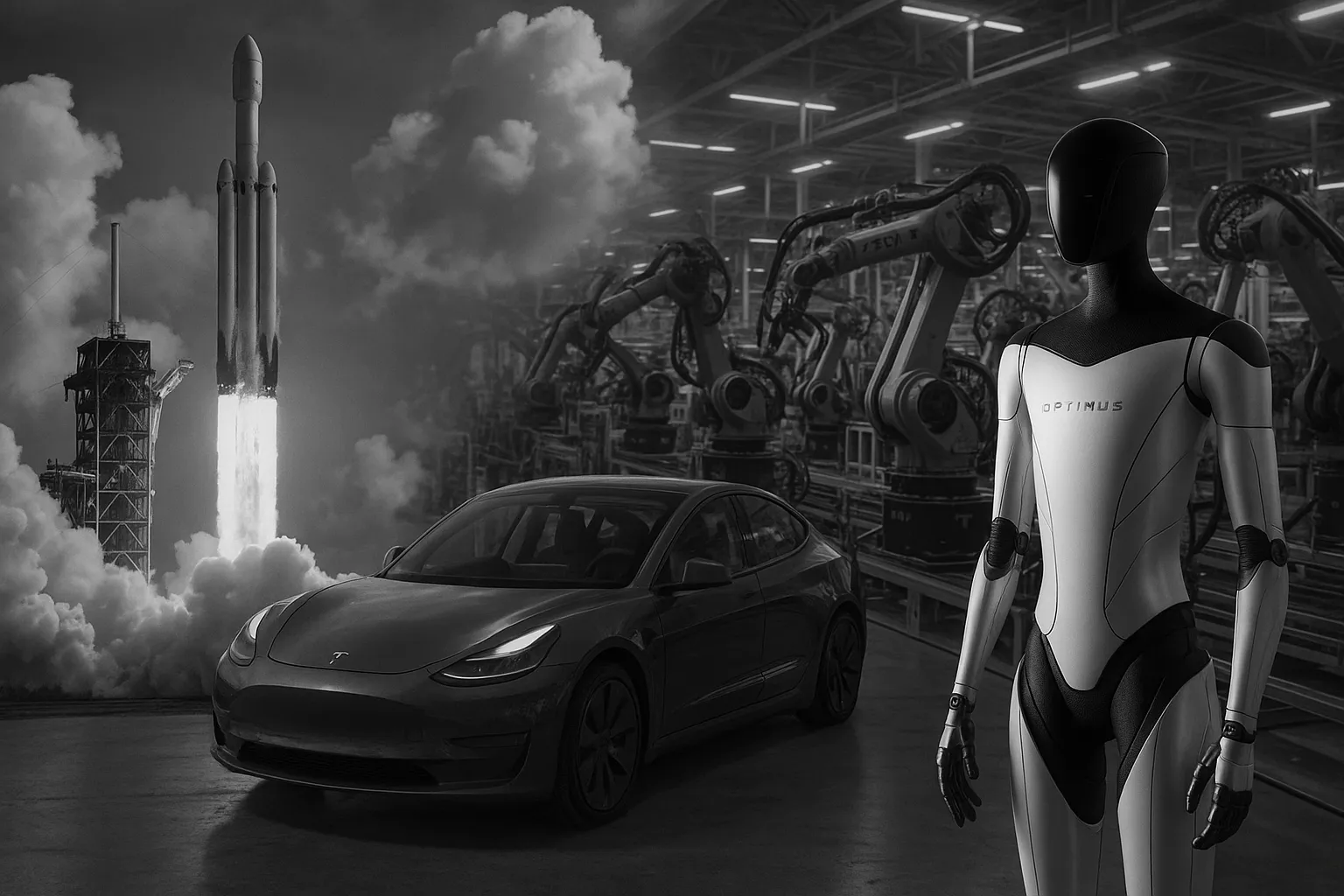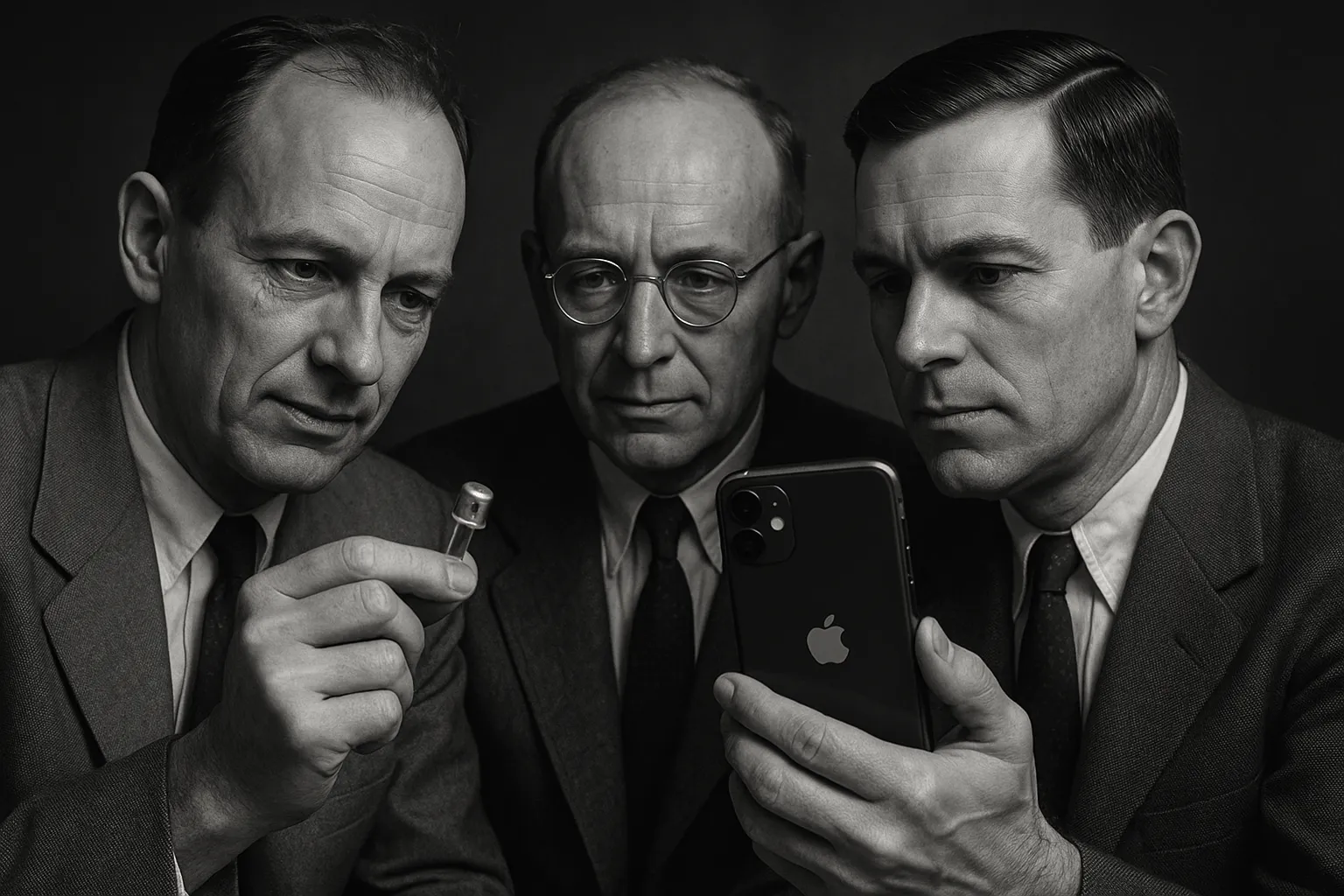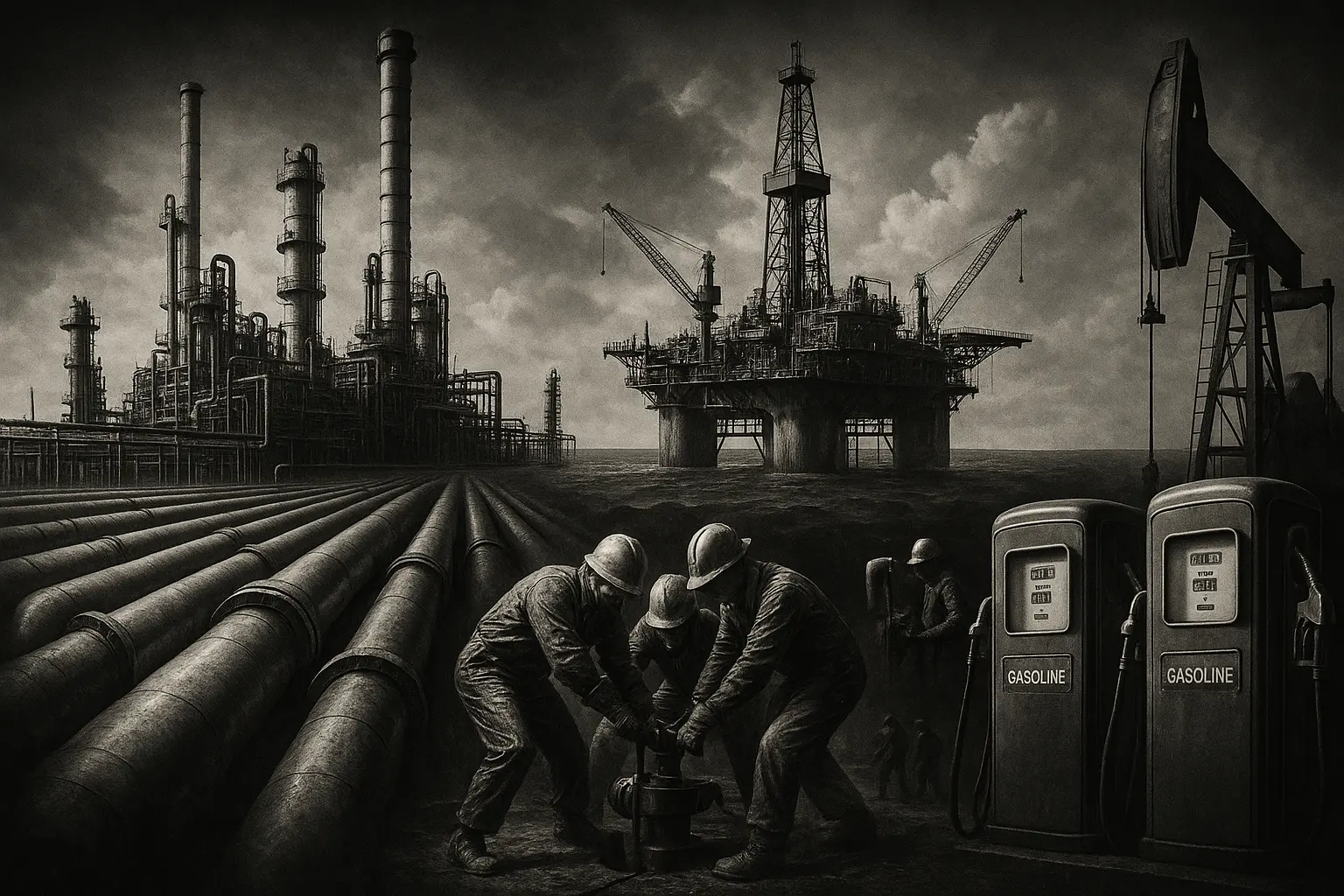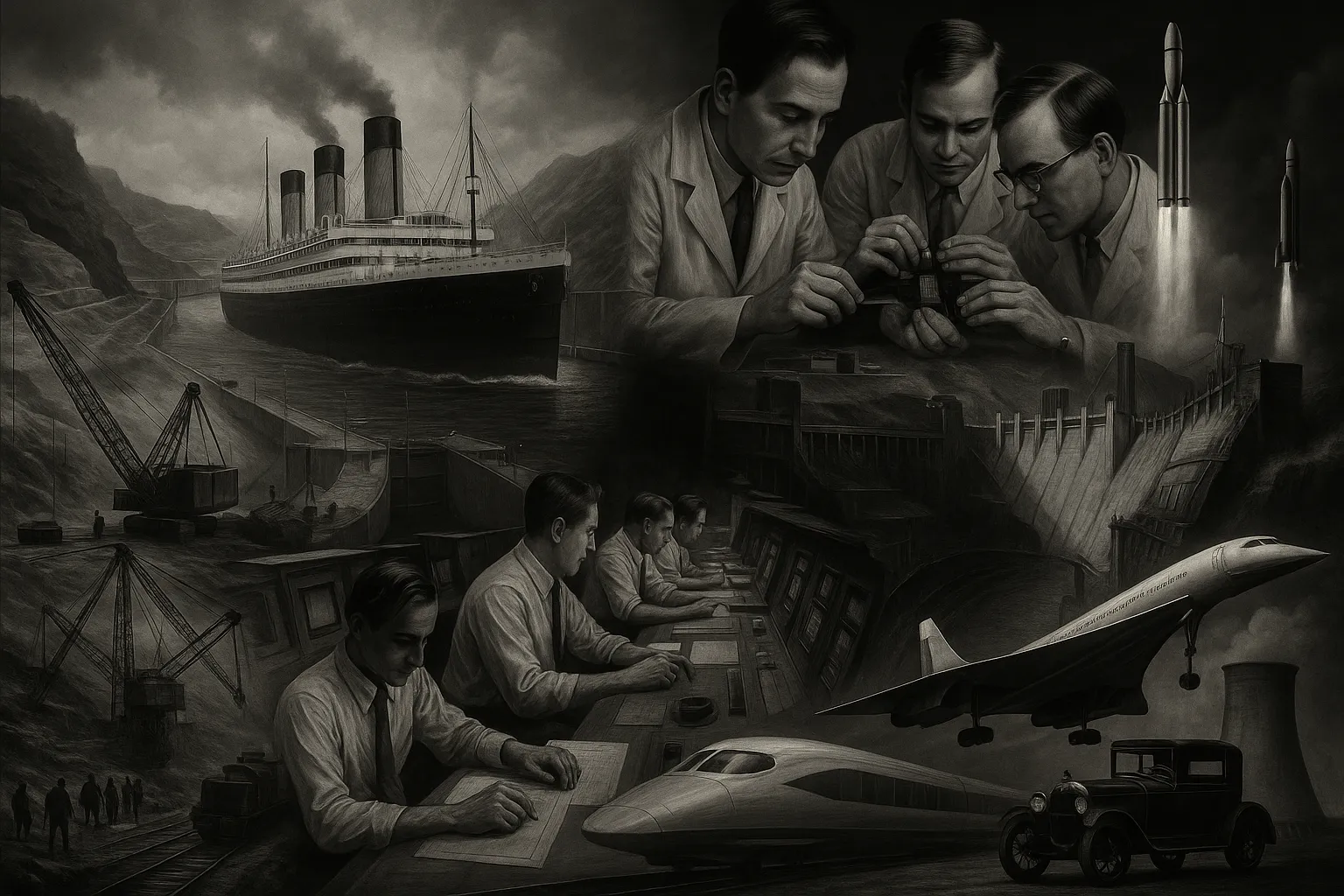
Proposition
People rely on projects to create everything.
Most of them fall behind schedule.
We have to stop this.
For the time-pressed, here are the key numbers: We accelerate execution of $10M+ projects across heavy industries—Oil & Gas, Nuclear, Renewables, Infrastructure, Manufacturing, and Defense. Our total addressable market is ~$46B/year, with an immediate $4.6B serviceable opportunity in oil & gas alone. Per project, we unlock over $50M in unrealized free cash flow (FCF) on small assets—and up to $4B on mega-projects.
If you have the time, are curious, or eager to prove us wrong, carry on. We promise you'll at least enjoy the pictures...

A broken system
Modern capital-intensive, multi-stakeholder projects in heavy industries—including Oil & Gas, Nuclear, Renewables, Infrastructure, Manufacturing, and Defense—suffer from chronic execution delays and cost overruns.
Despite billions spent on tools and technology over the past three decades, the vast majority of projects still run behind schedule.
A comprehensive EY study of 365 Oil & Gas megaprojects (valued at $1B+) found that 64% exceeded their budget and 73% faced delays, averaging nearly 2 years behind schedule.
Similarly, McKinsey reports that 80% of megaprojects in the O&G sector are both over budget and delayed.
(These are just two examples from the O&G industry alone—see more examples from every heavy industry in our research section.)
These statistics align with our co-founder's direct observations from 40+ years in the O&G industry, where he has witnessed these same patterns of delays and cost overruns firsthand.
While such studies may have their limitations, the evidence and trends are unmistakable—this is disaster.
We have to stop this.
These delays have severe impacts across the entire ecosystem:
- Slower time-to-revenue for asset owners
- Higher cost of capital and increased project financing risk
- Reduced profit margins
- Unpredictable resource allocation and volatile planning
- Higher costs directly related to project execution
The ripple effects are far-reaching:
- Economic growth slows down
- Goods and services become more expensive
- Energy costs soar
- Global innovation and risk-taking decline dramatically
The end result? Stagnation.

ai → AI
These issues stem from a combination of systemic challenges. Some of these are:
- Linear and Siloed Execution - Engineering, procurement, and construction teams operate in isolation, using sequential workflows that result in unreliable lead times, delayed deliveries, excess work-in-progress, increased rework, higher costs, extended waiting times (including the often overlooked "queue times"), misaligned priorities, and delayed feedback loops.
- Data Fragmentation & Readiness Blindness - There is no unified view across thousands of technical artifacts, line items, and procurement deliverables. This fragmentation leads to invisible blockers, unclear readiness, and reactive management.
- Poor Subsystem Prioritization - Projects rarely organize and control work according to system-critical paths (e.g., utility subsystems), resulting in disorganized sequences and delayed commissioning and startup.
- Vendor and Supply Chain Disconnection - Materials, vendor data, and equipment often arrive out of sync with engineering and field needs, leading to rework or idle crews.
- Lack of Predictive Intelligence - Decision-makers lack tools to model downstream impact (such as how a delayed requisition affects isometric drawings or subsystem activation) and predict the cascading effects of decisions.
- Misaligned Incentives - Current project structures reward individual actors for local optimizations rather than project success. This creates a "principal-agent" problem where departments act against the project's best interests.
At the core of these problems lies a neglected issue. The industry has focused on creating tools that optimize local optima but that don't address the real problem. We now have exceptional 3D modeling tools that create pixel-perfect diagrams and colossal machinery more powerful than an army of workers. Yet projects still fail to deliver because, while these tools excel at their specific tasks, they don't orchestrate the proper flow. So, drawings wait, machinery waits, humanity waits.
This core, neglected issue is a tale as old as time—a dangerous duo: arrogance and ignorance (ai).
The underlying problem isn't about tools - it's a human one - a behavioral problem.
Decision-makers either lack the knowledge needed to orchestrate and execute projects effectively, or they mistakenly believe that simple command-and-control management will suffice—or both.
AI is the technology we've been waiting for. With the right AI framework, we can overcome human limitations of arrogance and ignorance throughout the entire process, letting objective intelligence orchestrate the project and ensure proper flow.
We can finally execute a project the right way, the smart way.

Meet Allocc
Allocc isn't just another tool in your toolbelt that solves an isolated problem and optimizes it for local efficiency.
Allocc is an AI Execution Orchestration Platform that transforms project delivery.
By addressing systemic challenges head-on, we aim to reduce project duration by 50%. You read it right, 50%.
Allocc is a philosophy, a series of principles and strategies meticulously crafted to exploit and elevate every bottleneck in a project's critical chain. It's delivered and safeguarded through an AI platform. It's implemented implemented, customized, and monitoried on each project by a team of industry veterans - our support and integration services team.
In essence, it’s like having a dedicated elite EPC consulting team—working side by side with a live AI brain — focused entirely on delivering your project faster, cleaner, and with fewer surprises.
Just as comedy makes people think without realizing they're thinking, Allocc will guide teams to execute projects using a systems approach—without them even knowing it.
Simply put, Allocc determines what each project contributor should do and when they should do it. The "how" remains with their existing tools.
For example, in an Oil and Gas project, the piping team continues using their familiar 3D modeling tools and follows their established design rules—but Allocc guides them to work on specific drawings at precisely the right time to optimize the entire project.
Allocc replaces fragmentation with flow, blind spots with visibility, and reactive firefighting with proactive intelligence.

The Philosophy
At Allocc, we've combined proven tactics drawn from diverse schools of thought and refined through our co-founder's 40+ years of hands-on experience in the oil and gas industry.
Our pillars combine Systems Dynamics, Systems Thinking, Theory of Constraints, Organizational Theory, Lean and Six Sigma, and Critical Chain Project Management (CCPM)—paired with battle-tested maneuvers that come not from books, but from frontline experience.
We have developed an operational framework based on all of these principles. It's comprised of a set of tools and methodologies that we use to guide the execution of projects. We call these the Allocc "PFAT" (Project Flow Acceleration Techniques):
- Avoid multitasking
Multitasking creates turbulence and reduces operational effectiveness. - Last Planner Planning
Apply backward planning from startup to define critical completions. Focus commissioning sequence around system readiness and not only discipline progress. - Pathfinder Engineering Teams (akin to Palantir's FDEs)
Deploy multidisciplinary squads to unlock complex packages or high-risk areas early (e.g., flare, tankage, ESD loops). - Protect and prioritize flow, not capacity
"Lean" views extra capacity as "Muda" (waste). However, this principle only works in systems with extremely low variability—and projects in heavy industries are highly variable. Therefore, extra capacity, particularly when strategically allocated later in the project timeline, is crucial for protecting the project's flow. - Data centric - not "file" centric
Approval cycles for files are way slower than single data points, creating more queue and waiting times. Data centric approval cycles ensure faster and more continuous flow (laminar instead of turbulent). - Owners and contractors alignment via proper incentives and proper contractual structure
This is critical to ensure overall project success and prevent participants from optimizing their individual agendas at the expense of the whole. - Efficacy over efficiency
Efficiency often focuses on local optimizations, while efficacy addresses the optimization of the entire system. - Early Design Freeze for Long-Lead Procurement
Lock key specifications early to launch requisitions and vendor engagement before full model maturity. - Incentives over penalties
This is deeploy tied to behavioral economics. This simply drives better outcomes. - Single Ownership
Establish clear, singular ownership for every process and decision point to prevent diffusion of responsibility and ensure accountability. - Show Money Wasted per Hour of Delay to every contributor
Implement a dashboard displaying real-time cost of delay based on facility value ($/hour), enforcing urgency in all decisions. - Early Start-Up Team Integration
Involve construction and commissioning team from design stage to align operability, sequencing, and startup flows. - Deploy Rapid Interface Resolution Teams
Specialized teams dedicated to solving design, vendor, and construction conflicts as they arise. - System-Based Gating for Parallel Workflows
Break the project into functional systems (e.g., utilities, offsites, process). Apply independent gating milestones for each, enabling parallel execution and early commissioning. - Prioritize interfaces over tasks
Tasks themselves are usually well managed and controlled in the oil & gas environment—in fact, efficiency is constantly measured. The problem is that being extremely efficient at one task often means doing something that affects other tasks. Therefore, interface management must be top of mind for all project personnel. - Establish a prioritized relationship with specialized procurement companies
Long-lead equipment procured through specialized procurement companies typically arrives sooner because these "middleman" companies leverage their bulk purchasing power and vendor relationships with manufacturers. While this may increase per-item costs, the time savings—which unlocks unrealized revenue—far outweighs the expense. - Unite economic and technical decisions
When performing technical evaluations of equipment, there is a tendency to compartmentalize technical, commercial, and schedule aspects—which turns decision-making into a blind process with multiple owners. We need to avoid this. - Use "aggressive but possible" times rather than "highly probable" during planning phase and do not show the execution plan to contributors
During the planning phase, incumbents typically pad their timelines to ensure delivery within projections (using highly probable estimates). This behavior often leads them to procrastinate until the deadline (known as student syndrome). When conditions are favorable, they tend to expand the work to fill the allocated time (Parkinson's law). Moreover, people commonly add time buffers of twice the actual duration needed to protect themselves. syndrome). When conditions are favorable, they tend to expand the work to fill the allocated time (Parkinson's law). Moreover, people commonly add time buffers of twice the actual duration needed to protect themselves. All of these prevent typical "behavioral" undesired bottlenecks. - Use prefabricated skids when possible
Specialized vendors usually know better than general contractors what is really needed for special equipment to work properly. Their assumptions are therefore more aligned with reality and less prone to downstream project changes. - Data-Ready Execution Flow (Full-Kitting)
Don't start a task until all the required data is available to prevent turbulent information flow in the process. - Make extensive use of temporary Tie-Ins and Subsystem Startups
Allow early startup of subsystems via temporary loops or bypasses, even if upstream/downstream is not fully ready to ensure rapid commissioning. - Early Utility Commissioning
Fast-track utilities and offsite systems to enable early energization, testing, and system-by-system startup. So, even though this makes "construction" teams less "efficient", it optimizes the whole project flow. - Establish incremental model reviews
Conduct more frequent, focused reviews with reduced scope to identify issues earlier.
Does this work? Has it been tried? Well… Two data points:
- One of our co-founders has studied this for 40+ years (yes, he's a geek), and has implemented it for 20+ years on real projects. On a different scale, different reach, but same philosophy.
- We've identified partial implementations of these principles in isolated projects at major companies like Shell, TotalEnergies, and Petrobras.
Many of these principles are already implemented in the industry—but not in a centralized, standardized, and intelligent way. While some project managers apply some of these principles to specific projects, this piecemeal approach is simply not enough.

The Strategy
Our secret recipe is combining the "old", with the "new"; experience with energy; wisdom with technology. For each platform we create, we combine:
- The underlying Allocc Philosophy - the "meta skill".
- Technology. Software. AI. The "new", the delivery vehicle.
- A domain expert team - a group of veterans from each industry. The "old", the "experience". The "wisdom".
The Allocc Philosophy, distilled and perfected by AI, sets the direction. The domain expert team identifies the system's bottlenecks and defines the ideal solution, while the technology team builds it.
It's as "simple" as that.

The Magic of AI
Charlie.
Charlie is our is our brain—our intelligence engine, our AI Project Director. It learns not only through training from our domain expert teams but also from observing the actual execution of real projects.
Charlie sits at the heart of our knowledge flywheel—our most valuable asset.
Charlie launches with decades of combined experience. Its sole mission: to execute projects faster.
Let's stretch our imagination a bit—though we're confident you'll find it quite natural.
Picture how projects will look five years from now.
Charlie orchestrates the entire project execution autonomously. AI agents collaborate with humans on Engineering and Procurement tasks, while humans and robots work together on Construction activities.
The project's execution flow is managed by Charlie—no arrogance, no ignorance. Gone are local optimizations, perverse incentive structures, and performance bonuses for completing four hundred ISOs that weren't even needed to start the refinery's commissioning.
For the curious and technically savvy, Charlie is a collection of fine-tuned models and agents.
Supporting Charlie, we have "Palaestra" and "Thesaurus."
If you're familiar with Greek terminology, you'll recognize that Palaestra is our training infrastructure for ANIMUS. It learns in two ways:
- Through an internal-facing UI where our employees and selected contractors train the AI using reinforcement learning and human feedback (RL and RLHF)
- Through direct learning from each project's execution
Thesaurus serves as our underlying data layer. Since our software is AI-first, we vectorize and store every data point and document in an AI-ready format. This enables us to rapidly deploy AI functionality and positions us where, truly, the sky is the limit.
Charlie will make us move fast again.

The Opportunity. A tune of $46B per year.
The old story of the half-empty versus half-full glass rings truer than ever. Unfortunately, the optimistic "half-full" perspective does not reflect our current reality.
We face conflicts worldwide and internal struggles within our own societies. We have become drunk on peace - numbed into a state of stagnation. Our Judeo-Christian values, the foundations of freedom and democracy, are under threat. Our supply chains remain overly dependent on autocratic regimes.
As Peter Thiel notes: "The only thing that has moved fast in the past decades is the 'world of bits'." At Allocc, we question even this assessment—beyond a few revolutionary AI companies, we've mostly created "emojis."
We're leaving enormous progress on the table. By slowing down every major heavy industry in the West, we've slowed humanity's advancement. We possess the technical capability to build an energy infrastructure pillared on faster Oil and Gas production, Nuclear, and Renewables that could reduce costs to near zero—the cornerstone of abundance. We could create a robust physical communications network with expanded airports, railways, ships, rockets, and tunnels that would multiply our economic progress.
All these advances depend on successful projects. The only obstacle between this technical capability and reality is our lack of operational understanding in effective project execution. We're being held back by our own limitations—our arrogance and ignorance.
The Numbers. They're screaming; let's listen.
Let's begin by examining the opportunity cost in the Oil and Gas industry alone. We'll get to the other industries later.
When analyzing project delivery speed, there are multiple perspectives to consider:
- Financial aspect: NPV, interest rates on capital, IRR, and opportunity costs of alternative investments.
- Project capital expenditure: development costs incurred throughout the project lifecycle.
- Production opportunity cost: lost revenue from each day the facility (refinery, plant, factory, etc.) remains non-operational.
For this example, let's focus only on the opportunity cost—which we consider the most critical.
At today's price of $63 per barrel, an average refinery's daily processing capacity of 300K BPD, and FCF as 20% of revenue; project delays result in staggering losses. The calculation is straightforward: (300,000 barrels X $63) X 20% = $3.78M per day of unrealized FCF—that's almost $114M of unrealized FCF per month of non-production.
These delays directly impact the oil company's bottom line.
Time is the only non-recoverable resource.
Beyond financial metrics, there's a broader cost to society. Every barrel that fails to reach distribution raises energy and food prices. While this societal impact is harder to quantify, let's focus on the straightforward financial impact to oil producers.
If you are interested in the data sources, you can find them here. (Oil & Gas Project Delays file)
It's probably more than what we suspect.
An interesting fact about the Oil and Gas industry is that one of the most critical preconditions for approving a new project is a payout time generally around 3-4 years.
Do you see where this is going?
When Allocc cuts project time in half...
Let us connect the dots.
We can confidently predict that the entire market for O&G projects will double. And our TAM keeps growing—that's the beauty of the Matthew principle.
And even more important than our TAM and business opportunity—humanity moves faster.
One more detail… Politics.
Typically, political terms last 4-6 years, depending on the country. Politicians prefer investments they can complete during their term so they can claim credit—it's all about political capital.
Do you see where this is going?
All those mega projects that were previously dismissed because they would take 8-10 years are now back on the table.
More TAM, more opportunity, more progress.
Want a last one? Private capital… Many capital allocators won't touch mega projects that span 8-10 years due to the risk. But 4-6 years? That's much more enticing…

The Platforms.
Now that we have a pretty clear picture of the opportunity cost and the opportunity that Allocc has, not only to generate profit, but to contribute to human progress, let's dive into the strategic approach and technical aspect of our company.
So, we have developed a platform for each of the heavy industries listed above:
- Energy
- Oil and Gas → Hyperion: O&G
- Nuclear → Hyperion: Nuclear
- Renewables → Hyperion: Renewables
- Manufacturing → Vulcan
- Infrastructure → Terminus
- Defense → Parabellum
Phasing this out - a divide and conquer approach.
We have to practice what we preach—no multitasking (in case you forgot, it's one of our PFATs).
We need to crawl before we can run, so our rollout strategy follows a clear sequence. We begin with the Oil and Gas sector, with our platform "Hyperion." Why start here? We already have all three strategic foundations: the meta-skill, domain expertise, and technology. With our co-founder's extensive Oil and Gas experience, we'll achieve the fastest time-to-market and learn rapidly from both successes and setbacks.
Although Allocc conceptually works for any project, we target projects of $10M+ where we can provide the most leverage and potential benefit.
After mastering Hyperion (O&G), we'll expand into Hyperion (Nuclear). Our goal is to become the industry standard for fast project execution. By then, Allocc should be synonymous with "fast project." If we catch the nuclear wave before it scales worldwide, we'll be in an exceptional position to drive both economic value and industry impact.
Imagine the possibilities eight years from now—a world where we build small nuclear reactors and fusion plants in 4 years instead of ten.
After that, we can launch the remaining platforms one by one in a much faster timeframe, since we'll have mastered the entire platform creation process—from initial concept to product-market fit and successful project execution.

Hyperion - Oil and Gas.
Remember that Allocc is a combination of:
- An operating Philosophy - which translates into specific "tactics".
- The platform itself: software - AI - screens.
- A domain-expert team which help the customer implement these tactics and use our platform.
We'll explore the Hyperion platform through the first two aspects to give you a clear picture of our value proposition to customers.
The Philosophy.
Our "customer" is the Oil Company. Why? Because from the start, they align most closely with our goal—accelerating the project. No one is more interested in opening the valve as soon as possible than they are.
We first coordinate with the Oil Company to ensure that certain tactics are in place:
- Owner must maintain complete control over project decisions through a reimbursement-based scheme with EPC Contractors. This ensures all project participants focus on the single goal of accelerating project delivery—directly serving the Oil Owner's interests. This approach replaces the counterproductive "liquidated damages" scheme under which current projects operate.
- Establish performance bonuses for EPC Contractors that are directly tied to project completion speed.
- Dedicated procurement agency to maximize leverage with equipment suppliers, using a "just-in-time" material ordering process that eliminates lengthy requisition cycles.
- Offer substantial performance bonuses (2-3× standard profit margins) to equipment and material providers for early delivery of long-lead items in the critical path.
- Establish relationships with long-lead item manufacturers and optimize their internal processes through Allocc's Manufacturing Platform by implementing our defined principles to reduce cycle times.
- Procurement evaluation matrix must prioritize delivery time for long-lead items, as these typically determine the critical path.
- Pathfinders responsible for multi-discipline long-lead items (similar to Palantir's forward-deployed engineers). They must have approval authority—we can't waste speed gains on bureaucracy.
- Client specifications must be integrated into the Allocc Platform to ensure consistent checks throughout the project lifecycle.
- Among others...
Our domain-expert team manages this entire coordination process as part of our customized support and integration services. At this stage, the EPC contractor hasn't entered the picture yet—we're simply laying the groundwork.
Important note: Our domain-expert team initially comprises former big-EPC contractors (primarily from KBR). Most worked in KBR's "low-cost" office—which proved invaluable for their development. There, they were trained to handle the most complex project scenarios, as the "expensive" offices routinely redirected challenging projects to the low-cost center when crises emerged.
We've implemented an internal monitoring system linked to Charlie that enables our expert team to closely track and intervene in each project. We call this, the Mission Control Room (MCR). Through our "human" offering—a customized support team and integration services—every project benefits from our direct insights.
These experts are already at the cutting edge of their field. Imagine their capabilities after years of fine-tuning projects alongside ANIMUS.
The Screens.
Having analyzed the entire Oil & Gas project process, we've developed modules that target two key areas: tasks that create bottlenecks in the critical chain, and functions needed to implement our PFATs (previously discussed).
We've clearly outlined each module here:
Important disclaimer: Project acceleration success doesn't require implementing 100% of our tactics and tools. The system works incrementally. While not implementing a tactic means we won't reach full potential, you'll still see significant improvements. Simply put—the fewer tactics and modules a customer implements, the fewer benefits they'll realize.

The Pricing Model.
When a measure becomes a target, it ceases to be a good measure.
- Charles Goodhart
The famous "alignment" problem. Jensen and Meckling outlined this fundamental issue in 1976 as the Principal-Agent problem. Goodhart and Campbell also expanded on these insights.
Easy to understand - perhaps, hard to implement?
Our pricing model is straightforward: value-based pricing. We only get paid if we make the customer money.
Yes - we are arrogant, or ignorant. Or both? (We prefer: confident.)
We establish the industry average completion date with our veteran team's expertise. For every day we deliver ahead of schedule, we unlock additional value for the client. Our fee? 30% of that unlocked value.
For those who think that's insane—just look at Palantir's success with this model (or the top consulting firms, for that matter).
If you've been paying attention, you've likely noticed something fascinating. With our Philosophy, we've already aligned the Oil owner with the EPC contractor. Now, with our value-based pricing, all the parts are aligned:
- Oil owner - EPC Contractor
- Oil Owner - Allocc
- EPC Contractor - Allocc
We have flipped the whole ecosystem from: adversarial, penalty based, to, aligned- velocity incentivized collaboration.
Understanding and proposing this is pretty simple to understand. The execution part is where it gets tricky. The devil's in the details, as they say.
Here is where our three strategic pillars become our strengths:
- Our meta skill allows us to conceptually align everyone and operationally tie each department to the goal.
- Our software vehicle and AI is what allows us to monitor the actual, unmanipulated tasks time-to-completion of each department and individual contributor to the goal (no more local-optima, vanity metrics).
- Our domain-expert team is the one who gives us all the dirty little secrets of each department and the actual human behavior. They've all been there, they've all done that.

OE or PMC, only on steroids.
For those in the Oil & Gas industry, two key terms might come to mind: PMC (Project Management Consultant) and OE (Owner's Engineer).
Let us explain for those unfamiliar with the industry. In major O&G megaprojects, the project owner (Oil Company) hires a single company to manage their entire portfolio of project participants (EPC Contractors and others). This arrangement exists because of these projects' complexity, risk, and duration. This role typically goes to an EPC Contractor who didn't win the main project bid.
In other words, Oil Companies hire EPC contractors who lost the primary contract to oversee and manage the companies actually executing the project.
Allocc could be described as an OE/PMC on steroids. Our goal is to become the go-to OE/PMC for all Oil Companies. However, we won't simply supervise project execution. Instead, our AI-Centric Execution Orchestration Platform, combined with our team of industry veterans, will direct how projects should be executed and ensure they're carried out accordingly so that they're delivered 50% faster than the industry standard.
Remember those wild TAM numbers we threw you before? Well, the good news is that the OE/PMC ecosystem proves us right… Here's why.
| Project CapEx | Typical OE/PMC Fee (%) | Typical Fee (USD) |
|---|---|---|
| $100M – $500M | 3% – 5% | $3M – $25M |
| $500M – $1B | 2% – 3% | $10M – $30M |
| $1B – $5B+ | 1% – 2% | $10M – $100M+ |
So, we have a clear psychological anchor point with our potential customers. While these fees are just for managing projects, we have a very different value proposition. However, we won't be the only ones charging a percentage in a project—which represents millions of dollars.
For those who enjoy a good old analogy:
- We had Ford, GM, BMW → Then came Tesla.
- We had NASA, India, China, Russia → Then came SpaceX.
- We had Raytheon, Northrop Gruman, Lockheed Martin → Then came Anduril.
The market existed - they just found a pretty interesting and valuable way in. They re-imagined the landscape, and proposed a better solution. A tech-native one, a modern one.
We are fundamentally different from a typical OE/PMC company. While traditional OE/PMCs simply manage multiple players, we set the rules, implement our execution philosophy, and deploy our software platform. Still, the OE/PMC model serves as a useful reference point.
They manage. We accelerate.

Resistance to Change. A harsh reality.
We are not naive. This will not be a slam dunk on the first attempt. Changing an entire industry, especially one as powerful, profitable, and old as O&G, is not an easy task.
Yet, we are confident that the major struggle will be limited to the first project. For that one, we'll sweat—a lot.
For the second, we'll sweat—but just a little.
For the rest, they will come to us. We'll set the rules, and negotiations will be on our terms.
After all, unlocking an extra $300M in a single project "simply by hiring this new player, who carries zero risk since they only charge based on unlocked value," is a compelling proposition.

The rest of the platforms.
While we've focused deeply on the first platform only, we estimate that at least 80% of the Hyperion O&G modules would work with some minor tweaks.
This is where our domain-specific teams and Allocc strategy come into play. We'll combine vertical domain experts, tech teams, and meta-skill teams to craft each platform.
We'll leverage our experience: each new platform will benefit from the technical, methodological, and operational lessons learned from previous ones.
Most importantly, we'll leverage Charlie's knowledge to craft each new platform.

Wait. That's not all.
Our expertise lies in projects—we see the world through this lens and live and breathe project execution.
With this perspective, we've analyzed Western society's progress as a grand project. We've asked ourselves: what bottlenecks could prevent our great-grandchildren from living in an abundant and free society a hundred years from now?
Our analysis concludes there are six key bottlenecks:
- Energy (oil, gas, nuclear, renewables)
- Infrastructure
- Manufacturing
- Defense
We've already outlined our solutions for all of these, except two. These next two are "meta-bottlenecks" - they affect all of the above:
Innovation and Policy blockages.
Meet Athena and Plato.
These are not our current focus - but we want to give you a sneak peek at what we'll work on a few years from now.
Athena is our platform to accelerate startups. Plato is our platform to accelerate policy.

Almost There.
A quick recap
In essence, we are building a company that accelerates projects in heavy industries. We'll achieve this through a set of proven principles, delivered via an AI-Centric Execution Orchestration platform. Our team of industry veterans will ensure each platform effectively unlocks bottlenecks throughout the project's critical chain. By charging a percentage of the unlocked FCF, we'll establish a strong economic position—especially considering that speeding up projects can unlock hundreds of billions of dollars in value annually.
Our potential and goals are ambitious. With our two co-founders sharing 55 years of combined experience—including one who has managed billions in projects and thousands of people—we understand the importance of starting small. We know that before running, we must crawl. That's where our Hyperion platform for Oil and Gas comes in. We'll focus entirely on cracking this code first. Once we succeed, expanding to other platforms will be faster—a matter of rinse and repeat.
A project involves numerous human decisions and moving variables. Complexity is where AI shines. Unlike humans, AI has no opinions, arrogance, ignorance, memory lapses, favoritism, or conflicting incentives. It won't be swayed by friends asking for favors. A well-trained AI will consistently choose the best task to execute at any moment, ensuring the fastest possible delivery.
That's Charlie. That's what we're building.
Why now?
The timing could not be better. Juancho has accumulated over 15 years of tech experience and is ready. Juan is ready too—he's now focused on ensuring his grandchildren inherit a better world. His colleagues and close friends have 10–15 years left in their careers, along with the wisdom, networks, and experience that come from decades in the industry.
AI provides the framework that makes this all possible. Without AI, achieving a 50% reduction in project completion time would be nearly impossible. AI allows us to transform our principles and tactics into reality.
The market opportunity is clear: no one else has created what we envision—a company dedicated exclusively to accelerating heavy industry projects. This first-mover advantage, combined with AI-powered acceleration, would make us virtually unbeatable.
The geopolitical landscape favors us. We're in a world where expanding infrastructure, increasing energy capacity for AI demand, enhancing manufacturing capabilities, and strengthening defense sectors are top priorities—as evidenced by capital market movements.
So, the time is now. We need to run.
The Future
By now, it should be clear that this is far more than just economic rewards—we have a clear mission we must execute to turn our vision into reality.
The technical aspect of this vision involves a world where projects are autonomously orchestrated by the most advanced intelligence—one that harnesses human intellect and evolutionary progress while minimizing human flaws.
The more important aspect—the human one—envisions a future where peace, progress, stability, and abundance are the norm. A world with extremely cheap energy, reliable manufacturing of goods and services, peace through deterrence, and human infrastructure that elevates quality of life to new heights. We see a world where we build faster, smarter, and better, because building and creating gives our species meaning.

The End. The Beginning.
We're tired of discussions about "solving minor tooling problems" or "using AI to eliminate jobs, to cut costs." Unfortunately, many AI tools are indeed intended for that.
Let's focus our efforts on what really matters - the pillars for a healthy, robust, and long-lasting western society. We are at war with ourselves, we are attacking the values and methods that put us here - whether we like it not. We must shift our focus and wage war against complacency and stagnation.
The priorities and objectives of the shallow tools we've come up with lately is just a reflection of being drunk on peace - still in Woodstock. To survive, we need to build more, create more, fix more, help more. And "more" is not enough - it needs to be "fast", because the clock is ticking.
To wrap up - a few words from Juancho:
In my last 15 years, a "website going down" was considered a crisis-level event.
Working with my father now, I've learned that a real crisis is when a gas pipe explodes and you lose friends—when the children of those workers lose their fathers. A real crisis is a civil war - any war.
I used to think courage meant battling hackers who tried to take down a gossip website.
I've now learned that real courage is standing at 3 AM in front of a high-pressure pipe with a 50-ton excavator brushing just 3mm from it—not because you have to, but because leaving your crew face the danger alone while you're safe in the office, is not what you do.
Our parents, grandparents, and many generations behind, shed a lot of sweat, blood and tears to put us here. So to honor that, to honor the sacrifice they've made so that we can enjoy the freedoms we have - to honor the generation that built planes, trains, took us to the moon, invented the car, built those dams, mined those rocks, and set up the entire energy infrastructure with those oil rigs so that we can now consider a "bug", a crisis, we have to focus on the important stuff again.
We need to… we must.
Accelerate Projects.
Accelerate Progress.
Accelerate Humanity.
With conviction and hope for a faster future,